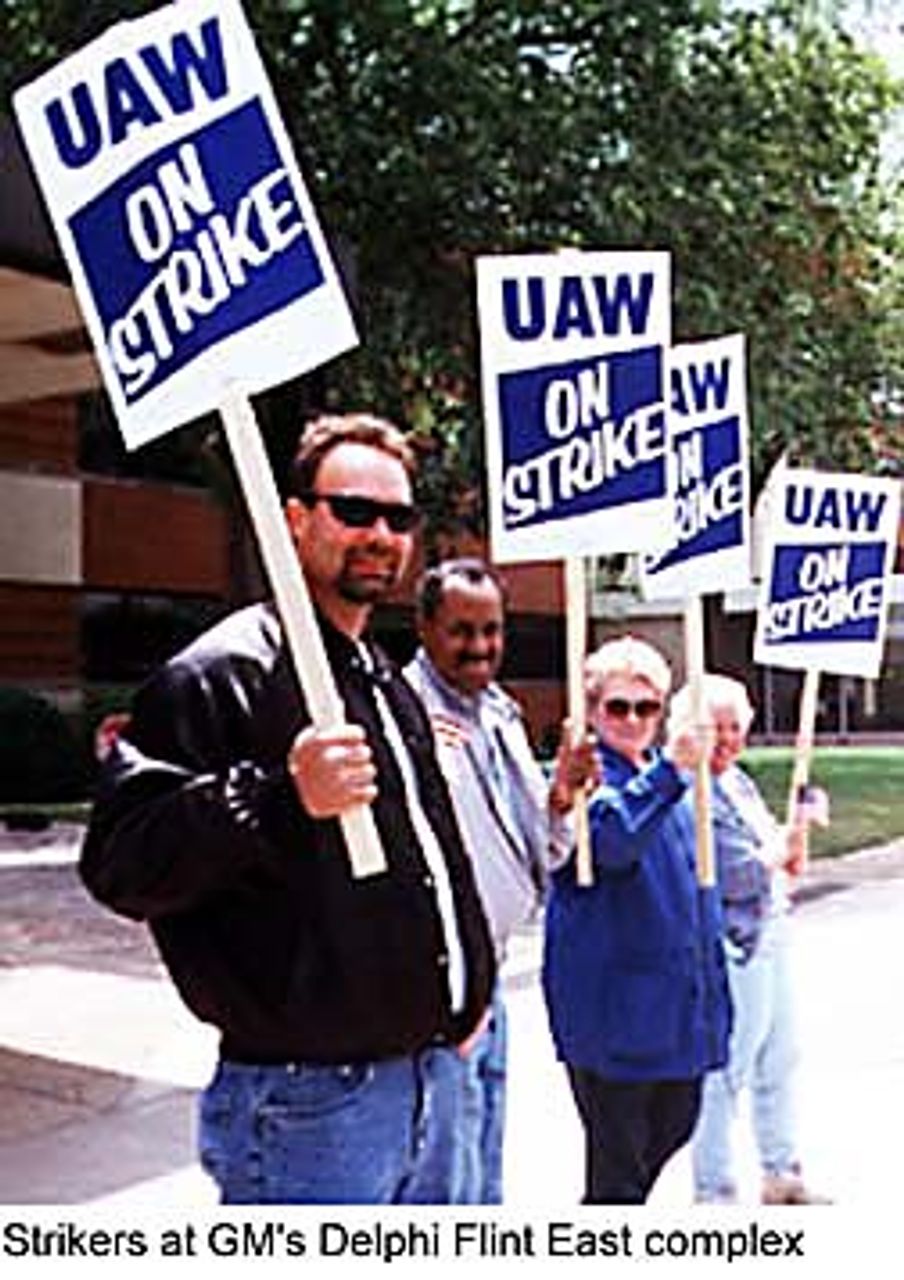 With the company-wide vacation period ending Friday, General Motors is intensifying its pressure on the United Auto Workers to end the two Flint, Michigan strikes that have led to the virtual shutdown of its North American operations. Negotiations involving top GM and UAW officials continued throughout the holiday weekend. Although bargainers called the sessions 'constructive,' no agreement has been reached.
With the company-wide vacation period ending Friday, General Motors is intensifying its pressure on the United Auto Workers to end the two Flint, Michigan strikes that have led to the virtual shutdown of its North American operations. Negotiations involving top GM and UAW officials continued throughout the holiday weekend. Although bargainers called the sessions 'constructive,' no agreement has been reached.
Talks continue to focus on work rules and investment at the Flint Metal Center, where workers struck June 5. GM has been pressing the union for a double-digit increase in the minimum daily output of engine cradles before it proceeds with a planned $180 million investment. UAW officials have said the company reneged on its pledge to upgrade the metal stamping plant even after the union instituted cost-cutting and productivity-boosting measures.
Behind the local issue, however, is GM's determination to win a clear victory over the UAW. Having already lost $1.2 billion in the strike, GM is demanding the UAW's full collaboration in accelerating its program of job elimination and further cost-cutting, and an end to crippling local strikes.
Wall Street investors, citing GM's more efficient domestic and international competitors, have expressed their dissatisfaction with the company's piecemeal approach to plant closings, layoffs and the elimination of slow selling car models. BusinessWeek magazine commented in its latest issue, 'Clearly, GM's decade-long 'death by a thousand cuts' strategy of gradual downsizing isn't working.' Investors, the magazine said, 'would applaud a broad restructuring that would finally get GM in fighting trim. That would mean cuts in management and hourly ranks, and revamping products, marketing and manufacturing.'
Citing sources close to GM, Tuesday's Wall Street Journal said the automaker will cut an additional 50,000 jobs or 22 percent of its hourly work force of 224,000, even though it has already eliminated 64,000 jobs since 1992. GM has invested billions of dollars in the past five years on new equipment and redesigned vehicles that require fewer labor hours. The Journal said company officials now feel they need to get a return on that investment, particularly in the face of a reinvigorated Ford Motor Co., and the Daimler-Chrysler merger.
According to the Detroit News 'GM executives are studying plans to replace aging assembly plants staffed by aging workforces with new plants that would employ a fraction of the workers now building cars in, say, Lansing or Lordstown, Ohio. The concept, dubbed Project Yellowstone, would enable GM to introduce world-class production methods akin to those it already uses in Eisenach, Germany, Argentina and Brazil.' In addition, the company is accelerating plans to sell all or part of its Delphi Automotive Systems parts unit, which employ 68,000 UAW members.
The UAW leadership, fearing the further loss of membership and dues income, has engaged in a series of 13 local strikes which have done little to stop the company's destruction of jobs. The union officials are not opposed, in principle, to GM's downsizing, but have pressed the company to work 'with the union' in this process. As UAW Vice President Richard Shoemaker said, 'All the auto companies are trying to improve productivity and we understand that. We've never told GM that we wouldn't help them become more competitive.'
BusinessWeek speculated that the UAW leadership could use the corporation's downsizing approach to its advantage. Commentator Bill Vlasic wrote that UAW President Stephen Yokich 'could agree to the export of low-tech parts jobs in exchange for a GM commitment to put new vehicles in aged US assembly plants.... The union also wants to expand its membership. It could work with the carmaker on that as well, giving GM the right to move, sell, or close parts plants in return for GM support of UAW organizing efforts at outside suppliers. Ford Motor Co. does it--and its profits and productivity don't seem to suffer because it buys from union shops.'
On the basis of such a quid pro quo the UAW bureaucracy could collect union dues from workers laboring in low-wage sweatshops, while GM was guaranteed the cost-cutting benefit of purchasing from outside suppliers.
In the meantime, GM has stepped up its plans, should the walkouts continue into August, to use outside parts suppliers in order to bypass the struck plants in Flint and restart selected assembly plants. The company has stated it would take legal action if auto workers in the US or Canada refused to handle such parts.
GM has also renewed its threat to end medical coverage for 163,000 workers idled because of the Flint walkouts. The 9,200 strikers have already been cut off. In an internal voice-mail message to managers, GM Vice President Donald Hackworth said the company would continue coverage for another week, but added, 'We have a contractual right to terminate coverage for UAW-represented employees sent home.'
See Also:
Discussions with General Motors strikers in Flint, Michigan
Workers grapple with the impact of globalization
[8 July 1998]
GM plans to bypass struck plants and resume production of key models
[3 July 1998]
